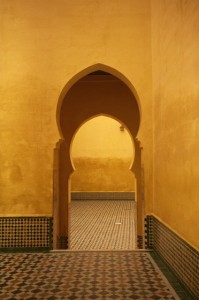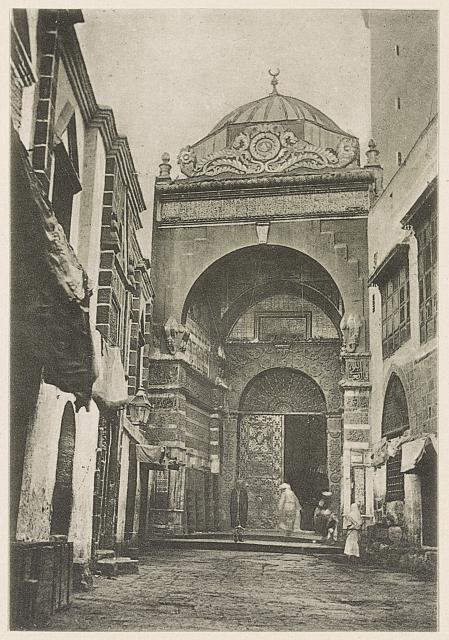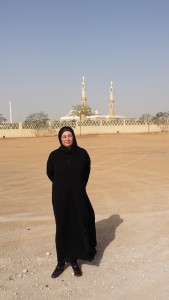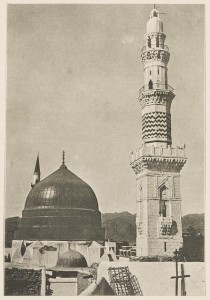Back home
 After a long, 14-hour flight, I am back at home. On the left is the mysterious photo taken by Tamara W. Hill in Meknes that I look at every day as I leave the house. It appears to be two images superimposed on each other, which is why it looks so jarring–as though there is something a little bit off kilter. I don’t have any mementoes of this trip to Saudi Arabia, probably because I never really got enough of an understanding of Riyadh. I don’t take photos on my trips–except to post on Facebook as a modern version of postcards–and I rely on physical objects to jog my memory. I did, however, bring back Arabic clothing, colorfully patterned and loose, which I will wear. I also have an abaya, the long black coat that Arab women wear, which was made in Clifton, New Jersey, in a shop run by Palestinian women from Jordan. Something about the cut reminds me of the clothes worn by women here in the 1950s. I can see in my mind’s eye all sorts of uses for that coat, but I think it is best left, folded and put away in the closet. One of the wonderful things about taking a trip–any trip–is coming back and seeing ordinary things in different way. I came back with a desire to think about technology and interconnectedness. About how communities can be formed through electronic media and mediation and how small opportunities and ideas can grow exponentially through crowd-sourcing. That’s all for now…..
After a long, 14-hour flight, I am back at home. On the left is the mysterious photo taken by Tamara W. Hill in Meknes that I look at every day as I leave the house. It appears to be two images superimposed on each other, which is why it looks so jarring–as though there is something a little bit off kilter. I don’t have any mementoes of this trip to Saudi Arabia, probably because I never really got enough of an understanding of Riyadh. I don’t take photos on my trips–except to post on Facebook as a modern version of postcards–and I rely on physical objects to jog my memory. I did, however, bring back Arabic clothing, colorfully patterned and loose, which I will wear. I also have an abaya, the long black coat that Arab women wear, which was made in Clifton, New Jersey, in a shop run by Palestinian women from Jordan. Something about the cut reminds me of the clothes worn by women here in the 1950s. I can see in my mind’s eye all sorts of uses for that coat, but I think it is best left, folded and put away in the closet. One of the wonderful things about taking a trip–any trip–is coming back and seeing ordinary things in different way. I came back with a desire to think about technology and interconnectedness. About how communities can be formed through electronic media and mediation and how small opportunities and ideas can grow exponentially through crowd-sourcing. That’s all for now…..





 This is now my third day lecturing at Princess Nora University Libraries. The campus itself is massive. PNU is the largest women’s university in the world, with 40,000 students. There is a monorail which transports the students from one end to the other. The building I am in is absolutely magnificent. Marble floors, high ceilings and what seems to be a sandstone exterior. Although I have been lecturing with a male Egyptian professor and translator I have not yet met the librarians. Because of the strict divisions between the sexes, we are in a another building across campus and leading this session via videoconferencing. So far, I have been unable to see the library administrators, although they can see us, and tomorrow I will go to the library myself for our first meeting. Riyadh itself is an enormous, far-flung city in a dry desert region of Saudi Arabia. The city is cosmopolitan, wealthy and multinational. People are drawn here from all corners of the Islamic world, Lebanon, Syria, the Sudan, Indonesia…In light of this being a “librarian’s” blog, as opposed to, say, a “traveler’s” blog, I will try to focus on observations that unite us as practitioners in two separate parts of the world. These sessions–four in all–consist of lectures, discussion, and group exercises on the topic of strategic planning. One of the inevitabilities of a discussion about strategic planning and libraries is that the various models used are based on business theory and stratagems, which both work and do not work for libraries. Academic libraries behave like non-profit institutions in their ethos and praxis–quite like their parent institution, the university. But they are run like small businesses. Many of the strategies involved in strategic planning do not quite “fit” libraries. In our discussions we tried to really understand some of the terminology, like SWOT analysis, conducting an environmental scans, KPIs and so forth and how they made sense for libraries. For me the most interesting discussion involved leadership styles. We went through the categories included in the Hay McBer styles of management and discussed their validity as useful constructs for managing people. I was happy to see that these women gravitated towards a democratic, i.e., participatory style of management–like their women colleagues in the US. It has also been extremely valuable to do exercises targeted to the tasks they will be doing as part of implementing the new strategic plan.
This is now my third day lecturing at Princess Nora University Libraries. The campus itself is massive. PNU is the largest women’s university in the world, with 40,000 students. There is a monorail which transports the students from one end to the other. The building I am in is absolutely magnificent. Marble floors, high ceilings and what seems to be a sandstone exterior. Although I have been lecturing with a male Egyptian professor and translator I have not yet met the librarians. Because of the strict divisions between the sexes, we are in a another building across campus and leading this session via videoconferencing. So far, I have been unable to see the library administrators, although they can see us, and tomorrow I will go to the library myself for our first meeting. Riyadh itself is an enormous, far-flung city in a dry desert region of Saudi Arabia. The city is cosmopolitan, wealthy and multinational. People are drawn here from all corners of the Islamic world, Lebanon, Syria, the Sudan, Indonesia…In light of this being a “librarian’s” blog, as opposed to, say, a “traveler’s” blog, I will try to focus on observations that unite us as practitioners in two separate parts of the world. These sessions–four in all–consist of lectures, discussion, and group exercises on the topic of strategic planning. One of the inevitabilities of a discussion about strategic planning and libraries is that the various models used are based on business theory and stratagems, which both work and do not work for libraries. Academic libraries behave like non-profit institutions in their ethos and praxis–quite like their parent institution, the university. But they are run like small businesses. Many of the strategies involved in strategic planning do not quite “fit” libraries. In our discussions we tried to really understand some of the terminology, like SWOT analysis, conducting an environmental scans, KPIs and so forth and how they made sense for libraries. For me the most interesting discussion involved leadership styles. We went through the categories included in the Hay McBer styles of management and discussed their validity as useful constructs for managing people. I was happy to see that these women gravitated towards a democratic, i.e., participatory style of management–like their women colleagues in the US. It has also been extremely valuable to do exercises targeted to the tasks they will be doing as part of implementing the new strategic plan.